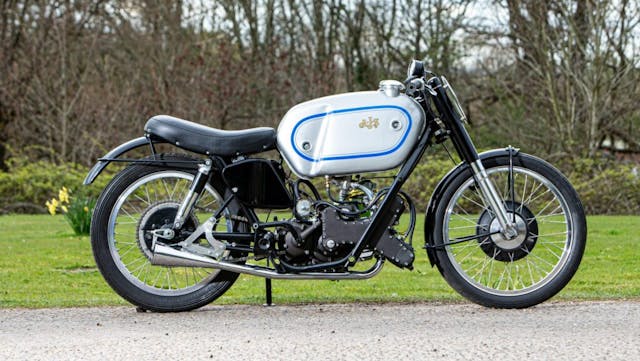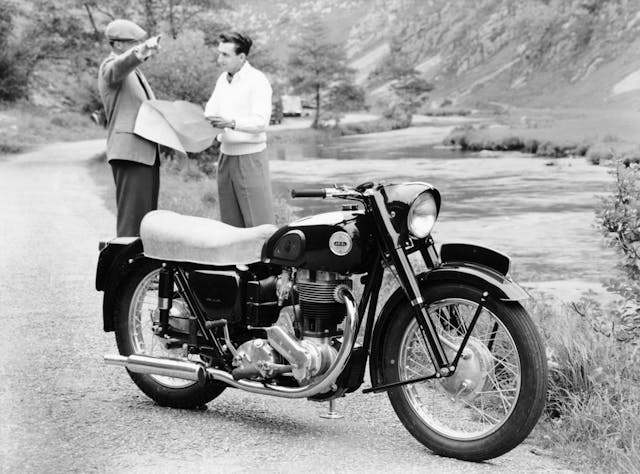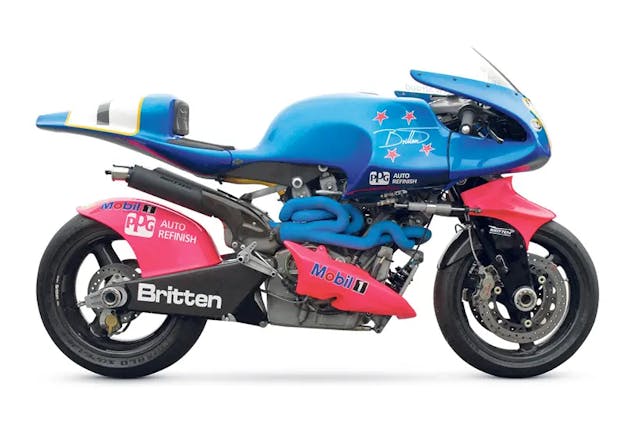These 9 bike brands are the best of Britain
Some of the oldest motorcycles in British two-wheeled history were seen only in small numbers when new in the U.S. As the United Kingdom ramped up production to pay off its burdensome World War II debt, eager Americans, flush with cash, were ready to purchase the latest offerings. The late 1940s and 1950s were boom years for most U.K. manufacturers.
Brough Superior
George Brough, creator of the great Brough Superior brand, was justifiably proud that his line of machines was hailed as the “Rolls-Royce of Motorcycles.” The cheeky young George’s father had been building Brough motorcycles for years, but George wanted higher performance with better components, so he audaciously called his machines Brough Superior. BS used a variety of engines depending on the client’s intended usage. The SS80, the Super Sports, used either a J.A.P. (John Alfred Prestwich, more commonly known as J.A. Prestwich, manufacturers of motorcycle engines for many brands from 1902 onward) or Matchless side-valve V-twin, but the ultimate model of the marque is undoubtedly the SS100.

The SS100 Alpine Grand Sport featured an overhead valve version of the J.A.P. engine, capable of 100 miles per hour. This speed was attested to following a test ride by the factory technicians, who painstakingly assembled each machine twice to ensure accuracy of component fit and performance.
It would take a movie about an unlikely war hero with a penchant for speed to put the Brough Superior in proper perspective and save it in our collective memories. T.E. Lawrence, better known as Lawrence of Arabia, had a love affair with his Brough motorcycles, including the SS100 on which he met his demise. Lawrence’s postwar life, including his passion for his motorcycles, can be seen in his book The Mint. His first Brough was named George. Then he purchased George II, III, IV, V, VI, and VII. He also referred to his Broughs as Boanerges or sometimes Boa, meaning Sons of Thunder. On these machines, Lawrence raced biplanes and trains. Surely the stuff of legends.
Vincent
When Philip Vincent’s father provided the funding to purchase the recently defunct HRD company in 1928, young upstart Philip set out to build the fastest, most glamorous motorcycle made at the time. He soon rivaled the much-vaunted Brough Superior by offering similar performance at a lower cost. Vincent knew good marketing, too, as the company brochure featured a striking illustration of the 1000-cc Series A Rapide Twin streaking across the page with a beautiful woman and sporting gentleman making good time on the handsome beast. Clarity of purpose and confidence can be felt through the ad copy: “Designed by enthusiasts for the discriminating rider” and “The world’s fastest standard motorcycle. This is a fact, not a slogan.”

American Rollie Free, wearing just a bathing suit, bathing cap, and borrowed sneak-ers, rode John Edgar’s Vincent Black Lightning prototype to a record 150.313 mph at the Bonneville Salt Flats on September 13, 1948. That photo of Rollie Free on the speeding Vincent is perhaps the most iconic image in all of motorcycling. Prewar Vincent HRDs are solid blue-chip collectibles, with the best of the big twins approaching $500,000 due to scarcity, desirability, and quality of construction. A postwar Vincent, such as the aforementioned Bathing Suit Bike, sold for a reported $1.1 million in 2010.
AJS

A.J. Stevens and Co., better known as AJS, was established in the pre–World War I period. Its success at the Isle of Man Tourist Trophy course led to the slogan “AJS, Racebred Motor Cycles,” which was often seen in their sales brochures. Facing financial difficulties in the 1930s, AJS was acquired by AMC, Associates Motorcycles, in 1938. It would produce its most iconic models in the early post–World War II era. Winning the inaugural 500-cc FIM World Championship in 1949 with Rod Coleman riding the innovative E90S “Porcupine” was the high-water mark for the brand. The Porcupine name came about because of the spike-like fins on the cylinders that aided cooling. AJS followed this up with the E-95, a three-valve “Triple Knocker” sporting a huge saddle fuel tank until 1954. This machine offered sophisticated design elements but was plagued with mechanical issues. Its on-track rival, Norton, used a double-overhead-cam single-cylinder engine to power its “featherbed”-framed Manx model, with the brilliant Geoff Duke riding one to a 500-cc World Championship in 1950.
Norton

Speaking of Norton, James Lansdowne Norton, or “Pa,” as he was known to his employees, scored some early success at the Isle of Man Tourist Trophy races with rider Rem Fowler in 1907 on a Peugeot-powered twin. From that point, it was single-cylinder engines that were most frequently associated with the marque’s racing successes for the next 50 years. Norton produced various production racers in limited numbers for years after that, such that nearly all the great racers of the 1950s and ’60s rode a Manx Norton model. The Nortons sponsored by John Player tobacco that Peter Williams rode in the 1970s utilized a Cosworth design and eventually rotary engines.
In the final years of production, Norton made a very alluring John Player Norton Commando for street use. It may have been no faster than its more pedestrian siblings, but it sure looked the part. One need only glance at the JPS livery and Union Jack flag on the tail section to identify it as a quintessentially British product of its time.
BSA

BSA, once the world’s largest producer of motorcycles, created the exquisite and versatile Gold Star model based on its exploits on the racetracks of England, particularly at Brooklands. In one last splash of glory before its bankruptcy, BSA sent a fleet of the best riders in the world to the famous Daytona Speedway in Florida armed with their Rocket III triples, taking a win there in 1971 with rider Dick Mann.
Triumph

Triumph is the brand that comes to mind first when thinking of British motorcycles. Although the company was founded by a German, Siegfried Bettmann, its home was in Coventry, England. Triumph made tens of thousands of single-cylinder motorcycles for the First World War, but it was the addition of the brilliant Edward Turner that helped birth the 500-cc Triumph Speed Twin in 1937. Triumph would become synonymous with parallel twin-cylinder engines from that moment on. While some might think of a late 1960s Bonneville as the epitome of classic Brits, its roots can be traced back to the prewar Speed Twin design. Notably, the Bonneville model was named to capitalize on the success of Texas-based Johnny Allen, who piloted a modified Triumph Thunderbird–powered streamliner called The Texas Cee-Gar to 214 mph on the Bonneville Salt Flats in 1956.
Americans were already worshiping at the altar of Triumph after the 1953 American film The Wild One, whose main character Johnny Strabler, played by Marlon Brando, rode a Triumph Thunderbird. The film was banned in the U.K. until 1968 due to its anti-authority storyline.
Ariel

British marque Ariel, founded in 1898 to produce motorized tricycles (not unlike the popular De Dion–powered models), catered to the well-heeled as well as the sportsman. Ariel hit its stride in the 1930s with the Red Hunter, a single-cylinder 350-cc; twin-cylinder, 500-cc machines, and the 1000-cc “Square Four,” which was launched in 1931 and went on to sell more than 15,500 units before its demise. This clever design sprang from the fertile mind of Edward Turner. It was, in essence, a pair of parallel twins with geared central flywheels, two transverse crankshafts, and a monoblock cylinder head. The continual evolution of the model saw the initial rigid frame with girder-style forks give way to plunger rear suspension and telescopic front forks. The original hand shift was eventually replaced by a foot-change gearbox, too. By the late 1950s, the brand had fallen on hard times and gambled its future on the more modern two-stroke range which included the ill-fated Leader and Arrow. It was a sad ending for what was once proclaimed to be “The World’s Most Exclusive Motor Cycle,” a reference to its Square Four model.
Veloce

Veloce Ltd. of Hall Green in Birmingham, England, was a family concern that made a comparatively modest quantity of motorcycles over its lengthy history. Veloce’s breakthrough model was the lightweight Velocette, launched in 1914. As a result of the name recognition, the motorcycles produced by Veloce would be known collectively as Velocette regardless of the type.
After World War I, some advanced four-stroke engineering by the young Percy Goodman, son of founder John Goodman (née Johannes Gutegmann of Oberwinter, Germany), would change the company’s trajectory. His overhead valve, 350-cc single-cylinder engine would be the genesis of roadsters and racers for years to come. Other innovations from Velocette included positive stop foot-change shifting and swinging-arm rear suspension. The ultimate double-overhead-cam 350 racer was the KTT. It won the first-ever F.I.M. 350-cc World Championship in 1949 with Freddie Frith and repeated the feat in 1950 with Bob Foster.
In its final form, the KTT Mark VIII featured Oleo Air rear shocks with Webb Girder front forks and overhead cams. Production of this over-the-counter production racer lasted from 1938 to 1950. After that, it was road-based equipment like the Viper, the Venom Clubman, and the 500-cc Thruxton models that kept the flame burning until the firm’s bankruptcy in 1970.
Britten

While geographically far from mainland England, New Zealand is part of the Commonwealth and shares enough DNA to be considered part of the United Kingdom for our purposes. New Zealander John Britten, although challenged with dyslexia, became an architectural designer and engineer, eventually turning his talents to racing motorcycle design. His eponymously named masterpiece, the Britten V1000, was launched in 1991. The innovative design made extensive use of carbon-fiber and Kevlar materials to form the bodywork, forks, swingarm, and wheels. It was powered with a double-overhead cam, 1000-cc liquid-cooled V-Twin engine and was immediately on par with other manufacturers’ factory efforts at the Battle of the Twins races around the globe. Just 10 Britten V1000 motorcycles were built between 1991 and 1998. John Britten died of inoperable skin cancer in 1995, robbing the world of a charismatic genius with a penchant for speed and style.
The British motorcycle industry went into a tailspin in the early 1970s that resulted in the closure of nearly all motorcycle manufacturing. It seemed all was lost until Englishman John Bloor relaunched the Triumph brand in 1983. However, nostalgia is a funny thing, and just as it fueled the comeback of cars such as the Volkswagen New Beetle and the Mini Cooper, Triumph found that the public wanted a machine that looked like the classic Bonneville. Carrying all the modern conveniences and reliability, they built a worthy successor to carry that name forward. Triumph’s rebirth has been followed by new motorcycles from Royal Enfield, Brough Superior, Matchless, Norton, and most recently BSA.
Anglophiles unite—our beloved Brits are back!
Motorcycles: Best of Britain is one of 20 classes to be featured at the 2023 Greenwich Concours d’Elegance, on June 2–4, 2023. Download the 2023 Greenwich Concours d’Elegance event program to learn more about Sunday’s other featured classes, Saturday’s Concours de Sport, our judges, sponsors, nonprofit partners, 2022 winners and more!
***
Check out the Hagerty Media homepage so you don’t miss a single story, or better yet, bookmark it. To get our best stories delivered right to your inbox, subscribe to our newsletters.


